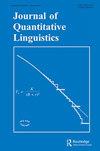Word Length Distribution in Zhuang Language
IF 1.7
2区 文学
0 LANGUAGE & LINGUISTICS
引用次数: 4
Abstract
ABSTRACT The present study focuses on the word length distribution (WLD) of Zhuang language. The results show that the WLDs of all texts investigated can be described by the Positive Cohen-Poisson model when the word length is measured by the syllable numbers. However, when the word length is measured by the letter numbers, they do not follow any model from the Poisson or Binomial distribution families widely observed in other languages. However, the WLDs of all the Zhuang texts investigated follow the Zipf-Alekseev function either in terms of syllable or letter numbers. Moreover, the research on the WLDs of different Zhuang genres indicates that WLD may not be a sensitive index in distinguishing different Zhuang genres but an effective one in distinguishing different Zhuang styles (spoken or written). Then, the study of the relationship between the parameters a and b in the Zipf-Alekseev function shows that the self-organizing regularity observed in other languages also exists in Zhuang. Finally, the study of the word length-frequency relationship of Zhuang indicates that Zhuang word length is influenced by its frequency, which can be explained by Zipf’s ‘Principle of Least Effort’ and thus follow the law of lexical synergetic subsystem in synergetic linguistics.壮语的词长分布
摘要本文主要研究壮语的词长分布。结果表明,当用音节数来衡量单词长度时,所研究的所有文本的WLD都可以用正Cohen Poisson模型来描述。然而,当用字母数字来衡量单词长度时,它们并不遵循其他语言中广泛观察到的泊松分布族或二项式分布族的任何模型。然而,所研究的所有壮族文本的WLD在音节或字母数方面都遵循齐普夫-阿列克谢夫函数。此外,对不同壮族语类WLD的研究表明,WLD可能不是区分不同壮族语类型的敏感指标,而是区分不同壮族风格(口语或书面)的有效指标。然后,对Zipf-Alekseev函数中参数a和b之间关系的研究表明,在其他语言中观察到的自组织规律在壮语中也存在。最后,对壮语词长频率关系的研究表明,壮语的词长受其频率的影响,这可以用齐普夫的“最小努力原则”来解释,从而遵循协同语言学中词汇协同子系统的规律。
本文章由计算机程序翻译,如有差异,请以英文原文为准。
求助全文
约1分钟内获得全文
求助全文
来源期刊

Journal of Quantitative Linguistics
Multiple-
CiteScore
2.90
自引率
7.10%
发文量
7
期刊介绍:
The Journal of Quantitative Linguistics is an international forum for the publication and discussion of research on the quantitative characteristics of language and text in an exact mathematical form. This approach, which is of growing interest, opens up important and exciting theoretical perspectives, as well as solutions for a wide range of practical problems such as machine learning or statistical parsing, by introducing into linguistics the methods and models of advanced scientific disciplines such as the natural sciences, economics, and psychology.
 求助内容:
求助内容: 应助结果提醒方式:
应助结果提醒方式:


